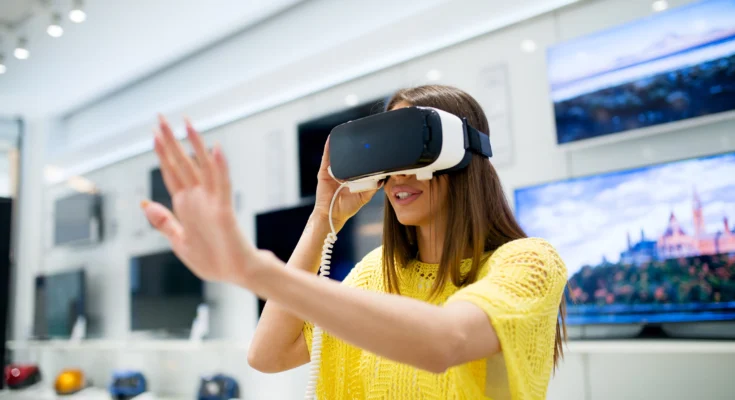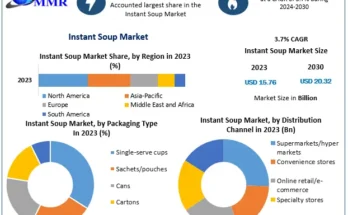Market Overview:
Virtual reality creates a completely immersive digital environment that replaces the user’s real-world surroundings. Users wear a VR headset that tracks their movements and displays 3D images and sounds that make them feel like they are inside the virtual environment. VR is commonly used in gaming, simulation training, and entertainment. Augmented reality, on the other hand, overlays digital content onto the user’s real-world environment. Users can see and interact with both the real world and digital content simultaneously through a device such as a smartphone or tablet. AR is often used in education, retail, and advertising to provide interactive and engaging experiences for users. Both VR and AR technologies have the potential to transform many industries and enhance the way we interact with digital content. AR and VR technologies have revolutionized the way customers interact with retail products. One of the most popular applications of AR and VR in retail is virtual try-on. By using these technologies, customers can virtually try on products such as clothes, accessories, and makeup without physically being in a store. This technology has several benefits, including reducing the need for physical inventory, increasing the customer’s convenience and satisfaction, and reducing the return rate.
Growing demands for personalized shopping is driving the Virtual and Augmented Reality in Retail Market growth
AR and VR technologies can also be used to create personalized shopping experiences for customers. By using these technologies, retailers can collect data about the customer’s preferences, shopping behavior, and purchase history to create a personalized virtual store or product catalog. For example, a customer could use a VR headset to enter a virtual store where they are greeted by a virtual sales associate who has already curated a selection of products based on the customer’s previous purchases and browsing history. The customer can then use the VR headset to explore and interact with these products in a personalized way. AR can also be used to create personalized shopping experiences by overlaying digital content onto the real-world environment. For example, a customer could use their smartphone to scan a product in a physical store, and then receive personalized product recommendations, reviews, and promotions based on their previous shopping behavior and preferences. Personalized shopping experiences can increase customer engagement and satisfaction, and also increase the likelihood of a sale. By using AR and VR technologies to create personalized shopping experiences, retailers can stay ahead of the competition and provide their customers with a truly unique and customized shopping experience. Such factors are propelling the growth of the Virtual and Augmented Reality in Retail Market.
Get Free Exclusive PDF Sample Copy of This Research: https://analyticsmarketresearch.com/sample-request/virtual-and-augmented-reality-in-retail-market/76684/
Segmentation:
By Technology:
• Virtual Reality (VR)
• Augmented Reality (AR)
By Device:
• Smartphones
• Tablets
• Smart Glasses
• Head-Mounted Displays (HMDS)
By Application:
• In-Store Navigation
• Product Visualization
• Marketing and Advertising
• Training and Education
Geography:
The Virtual and Augmented Reality in Retail Market is currently dominated by the North America region. North America has a highly advanced and mature technology market, with a large number of tech companies that are investing heavily in virtual and augmented reality technology. Many of the world’s leading VR and AR companies, such as Microsoft, Google, and Facebook, are based in North America, and are driving innovation in the field. North America has a large consumer market that is highly receptive to new and innovative technologies. Consumers in North America are early adopters of new technology, and are willing to spend money on new and exciting products that offer them unique and engaging experiences. North America has a well-established retail industry that is highly competitive and is constantly looking for new ways to engage customers and provide them with better shopping experiences. The use of VR and AR in retail is seen as a way to differentiate and stand out in a crowded market, and many retailers in North America are investing in these technologies to provide customers with more personalized and engaging experiences.
Impact of COVID-19 on the global Virtual and Augmented Reality in Retail Market:
The COVID-19 pandemic has had a significant impact on the Virtual and Augmented Reality in Retail Market. On one hand, the pandemic has accelerated the adoption of VR and AR technologies as retailers have looked for new ways to engage customers and provide them with personalized experiences in a socially-distanced environment. On the other hand, the pandemic has also disrupted supply chains and caused economic uncertainty, which has slowed down the growth of the market. One of the main impacts of COVID-19 on the Virtual and Augmented Reality in Retail Market has been the shift towards e-commerce and online shopping. As physical stores were closed during lockdowns and consumers became hesitant to visit stores in person, retailers turned to online channels to reach customers. Despite these challenges, the Virtual and Augmented Reality in Retail Market is expected to continue to grow in the coming years. The pandemic has highlighted the importance of these technologies in providing engaging and personalized shopping experiences, and as the world continues to recover from the pandemic, retailers are expected to invest more heavily in VR and AR technologies to meet the evolving needs of their customers.
Impact of the Russia-Ukraine War on the global Virtual and Augmented Reality in Retail Market:
Many VR and AR devices are manufactured in China, which is a major player in the ongoing conflict as a close ally of Russia. Any disruptions to the supply chain or manufacturing processes in China due to the conflict could have an impact on the availability and pricing of these devices, which may affect the growth of the Virtual and Augmented Reality in Retail Market. Additionally, the conflict may also have a negative impact on the overall global economy, which could affect consumer spending patterns and retailers’ willingness to invest in new technologies. As the Virtual and Augmented Reality in Retail Market is still in the early stages of development, it may be more vulnerable to economic disruptions than more established industries. It is important to note, however, that the impact of the conflict on the Virtual and Augmented Reality in Retail Market is difficult to predict and may depend on a variety of factors, including the duration and intensity of the conflict, as well as global geopolitical and economic conditions.
Company Profiles:
• Amazon
• Google
• Samsung Electronics
• Microsoft Corporation
• Qualcomm Technologies, Inc.
• Lenovo
• HP Development Company, L.P.
• Apple Inc.
• PTC Inc.
• Marxent Labs LLC
• Zara
• IKEA
• Sephora
• Lowe’s Companies, Inc.
• The Home Depot, Inc.
To Know More, Click here: https://analyticsmarketresearch.com/reports/virtual-and-augmented-reality-in-retail-market/76684/




